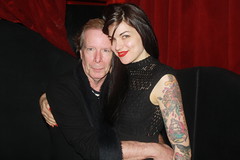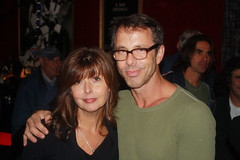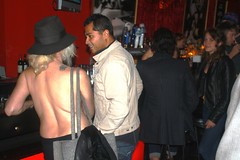Young hipsters and middle-aged punks collided at R Bar last night to celebrate the 67th birthday of rock ‘n’ roll photographer Bob Gruen.
Sporting a black blazer and blue scarf, the birthday boy greeted friends like punk journalist Legs McNeil and singer Jenni Muldaur, as well as younger admirers of his photography.
Mr. Gruen was one of the first – along with Godlis and our own Emily Armstrong and Pat Ivers – to heavily document the bands that played CBGBs and similar clubs in the 1970s. In the process, he snapped iconic photos of John Lennon, the Ramones, Blondie, Patti Smith, and others.
He said his mother, a photographer, introduced him to the craft by taking him to the dark room at the age of three. When he was a teenager, and rock ‘n’ roll came into its own, early classics by Bo Diddley and Chuck Berry made a lasting impression. At 18, he bought his first camera and became the family photographer.
The transition to rock photographer occurred when he moved in with a band called the Glitter House, and it was a natural one. “Rock bands are very much like families,” he told The Local last night.
As Mr. Gruen became part of the CBGB scene, he began working with the New York Dolls. “A lot of people assumed they were gay because of their makeup,” he said, “but in fact they were really macho guys that dolled themselves up, so to speak, to meet women.”
Through the Dolls, he met Malcolm McLaren, the impresario behind the Sex Pistols. “Malcolm was a very cool guy, a real genius who had an interest in chaos, quite the provocateur,” he recalled.
Despite his status as rock royalty, Mr. Gruen maintains an impressive humility. “I didn’t know at the time that something special was happening,” he said. “Things change gradually and punk wasn’t an overnight thing. A lot of bands that came around were good, and some made it and some didn’t. There were things going on before we ever used the term punk.”
The photographer recognizes the importance of the scene that he was part of, but doesn’t hold it overly precious and respects music of all generations. “I’m sure there are things going on in the Lower East Side or Brooklyn today, and 20 years from now people will be talking about how much fun they had back in those days,” he said. If there was anything special about CBGBs, he noted, it was that bands were writing and playing their own material, where bar bands usually stuck to covers of top 40 songs.
Mr. Gruen credits Hilly Kristal, the owner of CBGBs, with bringing together “a great party” consisting of “artists, writers, hangers-on, drunks and junkies”: “He didn’t want to be bothered with you, but if you did bother him he’d kick you out. If you don’t bother him, you can do whatever you want. That was what was great about CBGBs, the sense of freedom.”
So what’s next for the photographer? He spent a lot of time documenting Ike and Tina Turner in the early 70s and compiled his photos and video footage into a DVD, due out next month, that portrays the couple’s relationship before it lapsed into abuse and tumultuousness.
“Ike and Tina really liked each other,” said Mr. Gruen. “They were the hardest working band in show business, people used to say. Obviously there were very good reasons for why that couple split up, but their relationship wasn’t dark for a very long time, it was towards the end when too many stimulants turned the relationship dark. But our film shows why the couple had stayed together for 20 years before that.”







